Physical Address
304 North Cardinal St.
Dorchester Center, MA 02124
Physical Address
304 North Cardinal St.
Dorchester Center, MA 02124
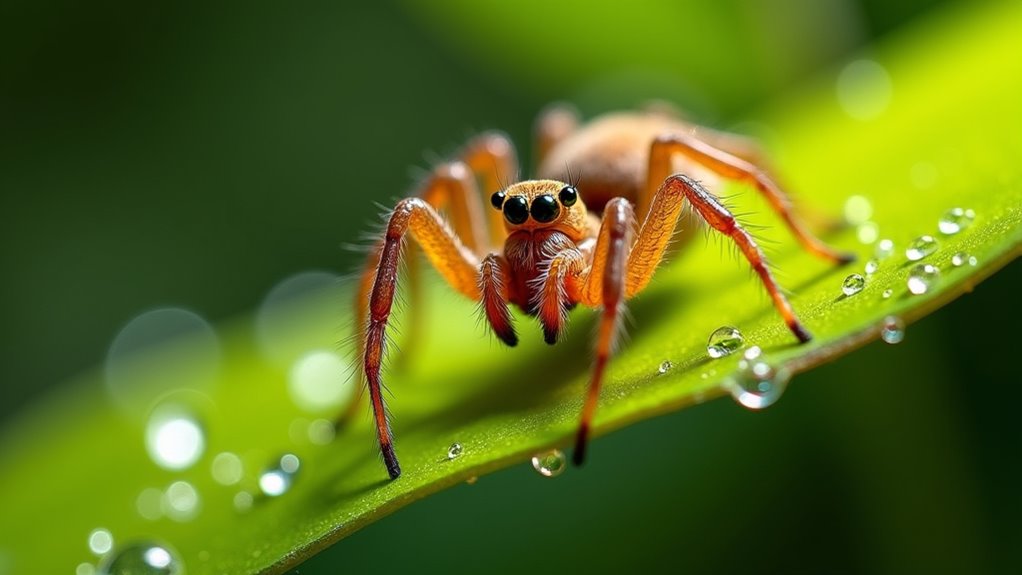
Discover Hawaii's spider spectrum from venomous widows to beneficial garden species, but which ones should truly make you nervous?
Hawaii hosts both dangerous and beneficial spiders. You’ll find venomous species like the Southern Black Widow and Mediterranean Recluse alongside non-aggressive varieties like the Hawaiian Garden Spider and Banded Garden Spider. Common urban species include Brown Widows, while the rare Kaua’i Cave Wolf Spider represents unique endemic biodiversity. Most Hawaiian spiders help control pests and rarely bite humans unless provoked. Discover which species you might encounter on your next island adventure.
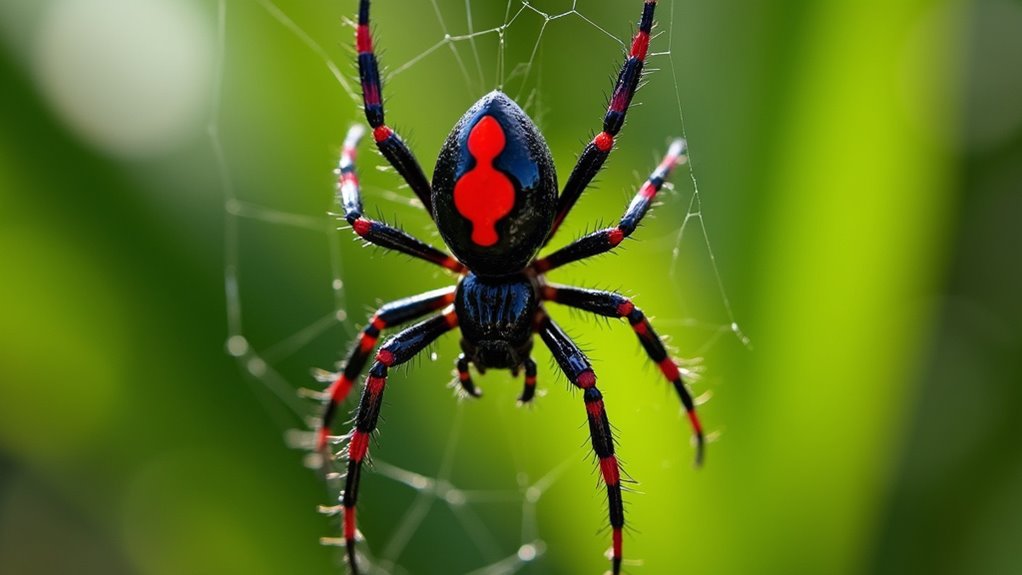
While Hawaii’s tropical paradise is home to many fascinating creatures, one of its most notorious residents is the Southern black widow spider (Latrodectus mactans).
You’ll recognize mature females by their shiny black bodies featuring the distinctive red hourglass shape on their underside. They’re notably larger than males, measuring 8-13mm compared to the males’ 3-6mm.
These venomous arachnids build strong, tangled cobwebs in sheltered areas like under rocks and in dark corners. Unlike their relatives, they’re less commonly found in urban areas, preferring arid and high-elevation locations throughout the islands. They’ve established themselves throughout the Hawaiian Islands, often arriving through imported produce.
Black widows lurk in Hawaii’s shadows, their messy webs hidden in protected spaces, arriving as unwelcome stowaways in mainland shipments.
If you’re unlucky enough to be bitten, you’ll experience severe pain, muscle cramps, and possibly respiratory distress. Always seek medical attention if symptoms persist.
Your best defense is avoiding dark, undisturbed areas where these spiders typically make their homes.
Unlike the more dangerous black widow, the Hawaiian garden spider (Argiope appensa) dazzles with its bright yellow and black patterns, making it one of the islands’ most visually striking arachnids.
Though native to the Western Pacific, you’ll now find these impressive orb-weavers throughout all main Hawaiian islands.
When exploring Hawaii’s gardens, parks, or forest edges, you’ll likely spot their distinctive webs with unique zigzag silk patterns called stabilimenta. The presence of these white zig-zag decorations may actually serve as a warning to prevent birds from flying into and damaging the web.
These spiders are most active during the rainy season from June to November.
Three fascinating facts about Hawaiian garden spiders:
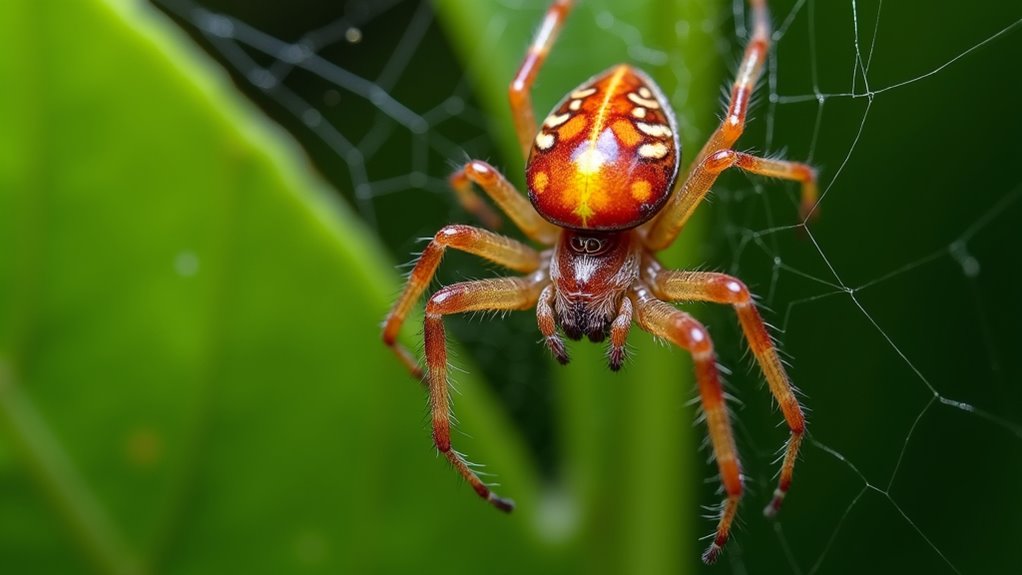
The Hawaiian garden spider may catch your eye with its vibrant colors, but the brown widow spider (Latrodopa geometricus) commands attention for a different reason. This less-shiny cousin of the black widow features a mottled tan and brown body with an orange-yellow hourglass marking on its underside.
You’ll likely encounter these spiders in urban settings around your home—under eaves, in garages, or among stored items. Though originating in Florida during the 1990s, they have since established a presence in Hawaii. Their distinctive spiky, thistle-like egg sacs contain up to 150 eggs each.
While females can bite, their venom is milder than a black widow’s, typically causing only localized pain.
Brown widow bites deliver a milder punch than their deadlier cousins, usually resulting in nothing more than site-specific discomfort.
Despite being less aggressive than their infamous relatives, brown widows are more common in residential areas. Unlike the marine creatures you might encounter while snorkeling in Lanai, these arachnids prefer dry, sheltered environments. Keep your home spider-free by removing clutter and sealing entry points.
Among Hawaii’s dangerous arachnids, the Mediterranean recluse spider (Loxosceles rufescens) deserves special attention as a stealthy invader. Originally from the Mediterranean region, this medium-sized spider with a violin-shaped marking has now established itself across multiple Hawaiian islands.
You’ll want to be cautious of these nocturnal hunters for three key reasons:
Recent evidence shows this species has been linked to serious health incidents, including two fatalities in Italy during 2024. Unlike invasive snakes that face strict import regulations in Hawaii, recluse spiders can easily hitchhike in shipping containers. To protect yourself, keep living spaces clean, seal potential entry points, and regularly check dark corners where these silent threats might lurk.
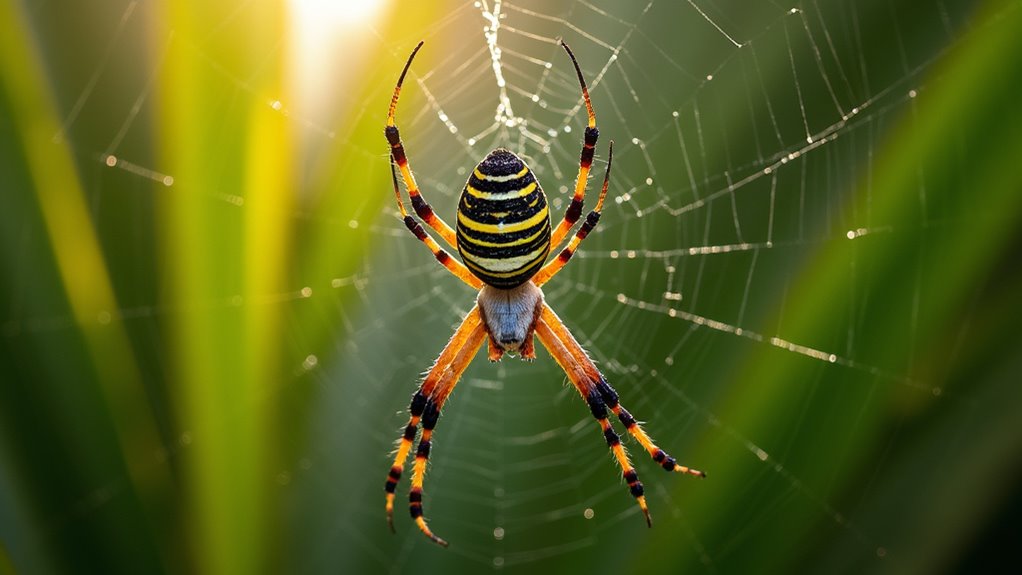
Moving from dangerous recluse spiders to more visible garden inhabitants, Hawaii’s landscape features the visually striking Banded Garden Spider. You’ll recognize this spider by its distinctive reddish-brown, black, yellow, and white bands adorning both abdomen and legs, with females considerably larger than males.
Though not native to Hawaii, these adaptable arachnids have established themselves throughout the islands. You’ll spot their impressive orb-shaped webs—sometimes reaching 60 cm in diameter—between plants and shrubs in your garden. A specific subspecies known as Argiope trifasciata kauaiensis has been identified in the Hawaiian archipelago. Like their Cuban counterparts, they display remarkable beauty despite their sometimes intimidating appearance.
These daytime hunters help control pests by capturing everything from small insects to large paper wasps. While they can deliver a moderately painful bite if disturbed (especially females guarding eggs), they’re generally harmless to humans and beneficial for your garden’s ecosystem.
Common throughout Hawaii’s homes and gardens, Barn Funnel Weavers build distinctive conical webs that you’ve likely encountered in undisturbed corners. These 7.5-11.5mm spiders have dark brown bodies with chevron patterns and banded legs, making them easily identifiable despite their shy nature.
The shy Barn Funnel Weaver spins its signature conical webs throughout Hawaii, recognizable by its chevron-patterned body and banded legs.
These non-aggressive arachnids prefer to avoid human contact and their bites are harmless. Their extremely fast movement allows them to quickly retreat when disturbed. They represent one of the most common species found across the Hawaiian islands.
You’ll typically find them in:
While females can live up to seven years producing multiple egg sacs, most outdoor spiders won’t survive winter’s cold.
Look for males and females sharing webs from May through July during mating season.
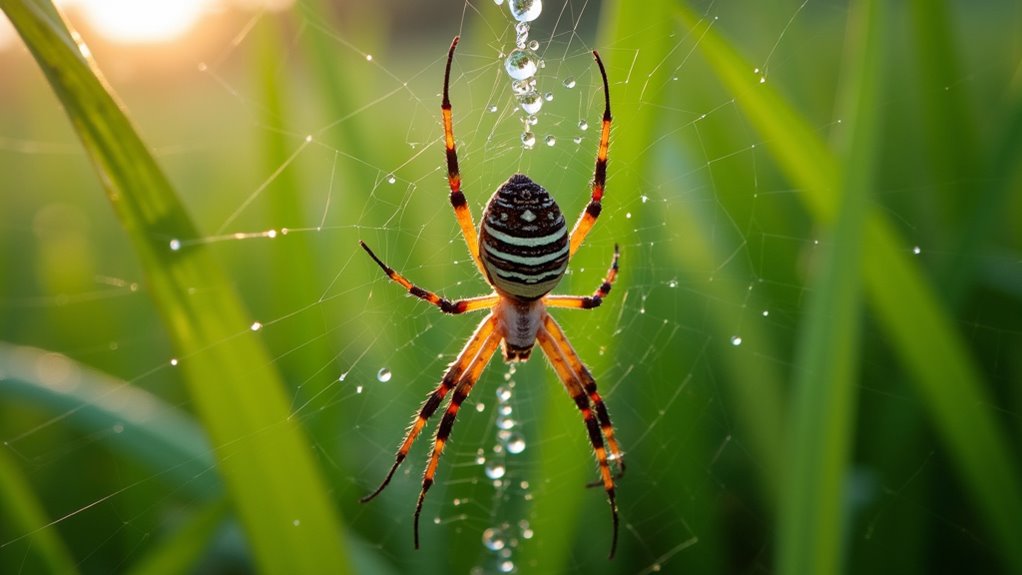
Have you ever spotted a small, striped spider darting across your lawn after disturbing its delicate web? You’ve likely encountered the American grass spider, an introduced species that’s now common throughout Hawaii.
These funnel weavers (family Agelenidae) measure 15-20mm long and build distinctive horizontal, sheet-like webs with funnel retreats. You’ll notice their webs most easily after morning dew, glistening across your lawn.
Unlike other spiders, their webs aren’t sticky—they catch prey through speed and agility.
You can identify grass spiders by their yellow to brown striped bodies and prominent spinnerets at their abdomen’s tip. Their carapace features two longitudinal stripes that distinguish them from similar-looking species. They’re beneficial garden residents, controlling insects like moths, crickets, and ants.
Though they occasionally enter homes, they’re primarily outdoor dwellers completing their one-year life cycle in your lawn. When encountering these spiders while exploring Hawaii’s natural areas, locals might refer to them using basic Hawaiian phrases that describe wildlife.
While relaxing in your Hawaiian garden, you might be completely unaware of the perfectly camouflaged predator lurking on nearby flowers. Crab spiders (family Thomisidae) are remarkable hunters that don’t build webs but instead use their crab-like appearance to ambush prey.
These small spiders (up to 10mm) are identified by their:
Hawaiian crab spiders might be tiny, but their distinctive flat bodies and long, claw-like front legs make them effective ambush hunters.
You’ll find these beneficial predators throughout Hawaii, controlling pest populations by feeding on flies, bees, and even aphids. Two distinct species are present on the Big Island, easily recognizable by their appearance – one white with black spots and six red spines, while the other displays shorter spines with white spots on a yellow-brown back.
While they can bite when trapped, they’re generally harmless and worth tolerating in your garden. Their presence makes Hawaii a unique blend of natural wonder and tropical celebration, quite different from the party atmosphere found in other Caribbean destinations.
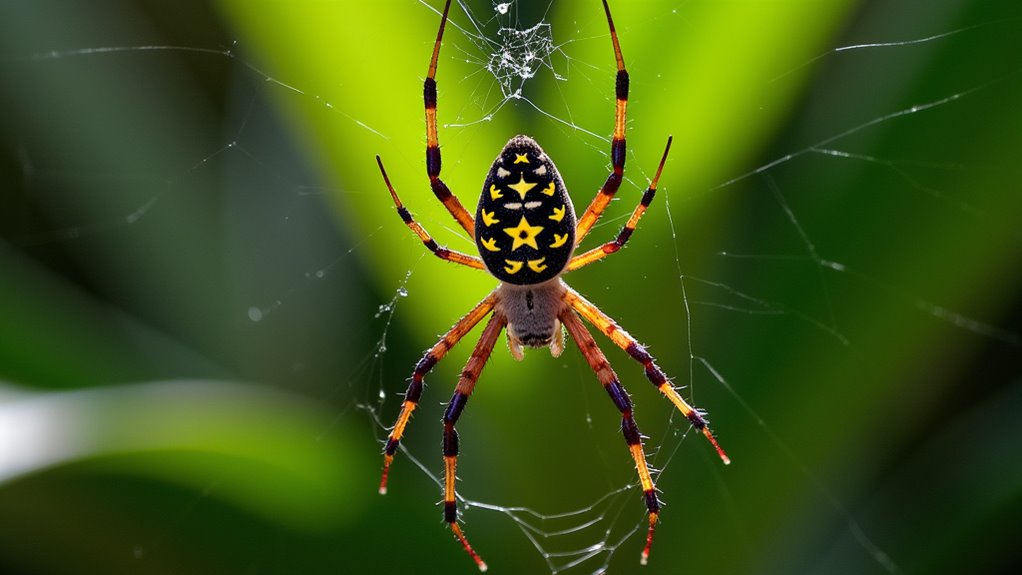
Looking up at a starry night sky, you might notice similar patterns on one of Hawaii’s most distinctive spiders. The Starbellied Orb Weaver (Acanthepeira stellata) features a spiky abdomen that radiates in all directions, resembling a tiny celestial body.
Though not native to Hawaii, these spiders have likely arrived through human activity. You’ll find them building wheel-shaped webs in sunny, open areas, typically within four feet of the ground. Their intricate webs can reach up to 30cm in diameter, serving as effective traps for flying insects.
The female, reaching up to 15mm, sits head-down at the web’s center while males are about 30% smaller.
If you disturb one, don’t be alarmed—they’ll quickly retreat or drop to the ground playing dead.
These beneficial arachnids help control flying insect populations, making them welcome residents despite their otherworldly appearance. While exploring Lanai’s natural highlights, you might encounter these fascinating spiders building their distinctive webs among the island’s diverse ecosystems.
Deep beneath the volcanic landscapes of Kaua’i lies one of Hawaii’s most extraordinary and elusive creatures. The Kaua’i cave wolf spider is a fully blind, cave-adapted predator found nowhere else on Earth but within a tiny 4-10.5 square kilometer area of lava tubes in the Koloa Basin.
In Kaua’i’s dark volcanic chambers, a blind hunter prowls—found nowhere else but these hidden Hawaiian depths.
This rare arachnid has evolved remarkable adaptations to its perpetual darkness:
Scientists have been studying this unique species since its discovery in 1971.
While distinct from the lush attractions of Kauai island that travelers typically visit, this arachnid represents the incredible biodiversity of Hawaii’s ecosystems.
You’ll likely never encounter this endangered species, as fewer than 30 have ever been observed during population counts.
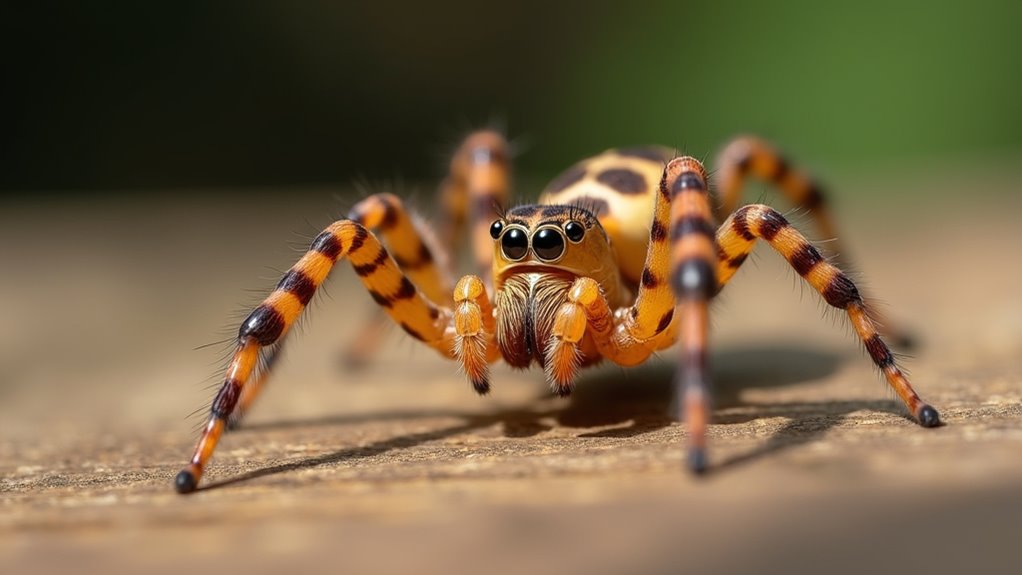
Despite persistent rumors and misidentifications, the Brown Recluse spider (Loxosceles reclusa) doesn’t call Hawaii home. What you’re likely seeing is its close relative, the Mediterranean Recluse (Loxosceles rufescens), which has established populations on at least four Hawaiian islands.
Both spiders feature the distinctive violin-shaped marking on their bodies and can deliver painful, potentially necrotic bites. The Mediterranean Recluse shares the same reclusive nature, preferring dark, dry areas like closets, basements, and stored items. These spiders typically reach a size of approximately a quarter long, measuring about 7-7.5mm with a light tan or dark brown coloration. Unlike the warm climate zones of mainland Canada, Hawaii’s consistent temperatures create ideal conditions for these arachnids year-round.
If you’re concerned about these spiders, inspect dark storage areas and wear gloves when handling items in secluded spaces. Remember, these spiders bite only when threatened.
For suspected bites, clean the area with soap and water and seek medical attention if severe symptoms develop.
While Hawaii’s tropical paradise teems with fascinating spiders, you’ve now got the lowdown on the islands’ eight-legged residents. From the deadly Black Widow to the rare Kaua’i Cave Wolf Spider, these creatures are as much a part of Hawaii as the swaying palm trees. Remember, most spiders you’ll encounter are simply nature’s pest control experts, working silently behind the scenes to keep the island ecosystem in balance.